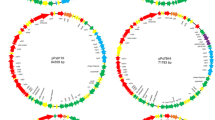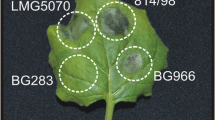Abstract
The hrpS to hrpB regions from strains of Pseudomonas syringae were amplified by polymerase chain reaction (PCR) and the DNA sequence determined. The order of hrpS, hrpA, hrpZ, and hrpB was consistent among P. syringae strains. The sequence of hrpS was highly conserved. In a cluster analysis with the hrpS sequence, P. syringae strains were divided into four groups (I, II, III, and IV) and one undetermined strain, in agreement with previous studies. In contrast, the hrpZ sequences contained insertions, deletions, and base substitutions followed by changes in amino acids. Based on cluster analysis of hrpA, hrpZ, and hrpB, P. syringae strains could be divided into five groups. One of the four groups (group I) in the cluster analysis of hrpS could be further divided into two subgroups (groups IA and IB). Groups II, III, and IV were the same in the two analyses. Group-specific primers were designed, based on the DNA sequences of hrpZ, that could differentiate the groups of P. syringae strains.
Similar content being viewed by others
References
JR Alfano AO Scharkowski WL Deng JL Badel T Petnicki-Ocwieja K van Dijk A Collmer (2000) ArticleTitleThe Pseudomonas syringae hrp pathogenicity island has a tripartite mosaic structure composed of a cluster of type III secretion genes bounded by exchangeable effector and conserved effector loci that contribute to parasitic fitness and pathogenicity in plants Proc Natl Acad Sci USA 97 4856–4861 Occurrence Handle10.1073/pnas.97.9.4856 Occurrence Handle1:CAS:528:DC%2BD3cXivFKju74%3D Occurrence Handle10781092
FM Ausubel R Brent RE Kingston DD Moore JG Seidman JA Smith K Struhl (1992) Current protocols in molecular biology Wiley New York
U Bonas (1996) Hrp genes of phytopathogenic bacteria JL Dangl (Eds) Bacterial pathogenesis of plants and animals Springer Berlin 79–98
JC Charity K Pak CF Delwiche SW Hutcheson (2003) ArticleTitleNovel exchangeable effector loci associated with the Pseudomonas syringae hrp pathogenicity island: evidence for integron-like assembly from transposed gene cassettes Mol Plant-Microbe Interact 16 495–507 Occurrence Handle1:CAS:528:DC%2BD3sXjvFOqsrw%3D Occurrence Handle12795376
L Gardan H Shafik S Belouin R Broch F Grimont PAD Grimont (1999) ArticleTitleDNA relatedness among the pathovars of Pseudomonas syringae and description of Pseudomonas tremae sp. nov. and Pseudomonas cannabina sp. nov. (ex Sutic and Dowson 1959) Int J Syst Bacteriol 49 469–478 Occurrence Handle1:CAS:528:DyaK1MXjt1Cru74%3D Occurrence Handle10319466
SY He HC Huang A Collmer (1993) ArticleTitlePseudomonas syringae hrp pv. syringae harpin Pss: a protein that is secreted via the Hrp pathway and elicits the hypersensitive response in plants Cell 73 1255–1266 Occurrence Handle1:CAS:528:DyaK3sXmsVGjtrc%3D Occurrence Handle8324821
CJ Hueck (1998) ArticleTitleType III protein secretion systems in bacterial pathogens of animals and plants Microbiol Mol Biol Rev 62 379–433 Occurrence Handle1:CAS:528:DyaK1cXkt1Oitb4%3D Occurrence Handle9618447
Y Inoue Y Takikawa (1999) ArticleTitleGrouping Pseudomonas syringae strains by comparing DNA homology at the hrp gene cluster and its neighboring regions Ann Phytopathol Soc Jpn 65 32–41 Occurrence Handle1:CAS:528:DyaK1MXmsVGnt74%3D
Y Inoue Y Takikawa (2000) ArticleTitlePseudomonas syringae hrp strains are classified into five groups by comparing DNA homology at the hrp neighboring regions J Gen Plant Pathol 66 238–241 Occurrence Handle1:CAS:528:DC%2BD3cXosFOks7k%3D
Y Inoue Y Takikawa (2003) Phylogenic analysis of DNA sequences around the hrpL and hrpZ regions of Pseudomonas syringae group bacteria NS Iacobellis A Collmer SW Hutcheson JW Mansfield CE Morris J Murillo NW Schaad DE Stead G Surico (Eds) Pseudomonas syringae pathovars and related pathogens Kluwer Dordrecht 687–695
JF Kim ZM Wei SV Beer (1997) ArticleTitleThe hrpA and hrpC operons of Erwinia amylovora encode components of a type III pathway that secretes harpin J Bacteriol 179 1690–1697 Occurrence Handle1:CAS:528:DyaK2sXhsFGntLc%3D Occurrence Handle9045830
CM Li I Brown JW Mansfield C Stevens T Boureau M Romantschuk S Taira (2002) ArticleTitleThe Hrp pilus of Pseudomonas syringae elongates from its tip and acts as a conduit for translocation of the effector protein HrpZ EMBO J 21 1909–1915 Occurrence Handle1:CAS:528:DC%2BD38Xjs1WhurY%3D Occurrence Handle11953310
G Preston HC Huang SY He A Collmer (1995) ArticleTitleThe HrpZ proteins of Pseudomonas syringae pvs. syringae, glycinea and tomato are encoded by an operon containing Yersinia ysc homologs and elicit the hypersensitive response in tomato but not soybean. Mol Plant Microbe Interact 8 717–732 Occurrence Handle1:CAS:528:DyaK2MXovVOmur0%3D
E Roine W Wei J Yuan EL Nurmiaho-Lassila N Kalkkinen M Romantschuk SY He (1997) ArticleTitleHrp pilus: an hrp-dependent bacterial surface appendage produced by Pseudomonas syringae pv. tomato DC3000 Proc Natl Acad Sci USA 94 3459–3464 Occurrence Handle10.1073/pnas.94.7.3459 Occurrence Handle1:CAS:528:DyaK2sXisVKnsL0%3D Occurrence Handle9096416
H Sawada F Suzuki I Matsuda N Saitou (1999) ArticleTitlePhylogenetic analysis of Pseudomonas syringae pathovars suggests the horizontal gene transfer of argK and the evolutionary stability of hrp gene cluster J Mol Evol 49 627–644 Occurrence Handle1:CAS:528:DyaK1MXnsVajtr8%3D Occurrence Handle10552044
F Taguchi R Tanaka S Kinoshita Y Ichinose Y Imura S Andi K Toyoda T Shiraishi T Yamada (2001) ArticleTitleHarpinpsta from Pseudomonas syringae pv. tabaci is defective and deficient in its expression and HR-inducing activity J Gen Plant Pathol 67 116–123 Occurrence Handle1:CAS:528:DC%2BD3MXmtVGru7s%3D
S Taira J Tuimala E Roine EL Nurmiaho-Lassila H Savilahti M Romantschuk (1999) ArticleTitleMutational analysis of the Pseudomonas syringae pv. tomato hrpA gene encoding Hrp pilus subunit Mol Microbiol 34 737–744 Occurrence Handle10.1046/j.1365-2958.1999.01635.x Occurrence Handle1:STN:280:DC%2BD3c%2Fjt1SntQ%3D%3D Occurrence Handle10564513
Y Takikawa Y Inoue (2003) Taxonomy of Pseudomonas syringae pathovars: classification and nomenclature NS Iacobellis A Collmer SW Hutcheson JW Mansfield CE Morris J Murillo NW Schaad DE Stead G Surico (Eds) Pseudomonas syringae pathovars and related pathogens Kluwer Dordrecht 645–652
JD Thompson TJ Gibson F Plewniak F Jeanmougin DG Higgins (1997) ArticleTitleThe ClustalX windows interface: flexible strategies for multiple sequence alignment aided by quality analysis tools Nucleic Acids Res 24 4876–4882
Author information
Authors and Affiliations
Corresponding author
Additional information
The nucleotide sequence data reported are available in the DDBJ/EMBL/GenBank databases under the accession numbers AB112552 to AB112581
Rights and permissions
About this article
Cite this article
Inoue, Y., Takikawa, Y. The hrpZ and hrpA genes are variable, and useful for grouping Pseudomonas syringae bacteria. J Gen Plant Pathol 72, 26–33 (2006). https://doi.org/10.1007/s10327-005-0240-1
Received:
Accepted:
Issue Date:
DOI: https://doi.org/10.1007/s10327-005-0240-1




